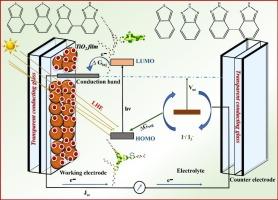DFT和TDDFT对三苯胺基染料光电性能的研究:π-间隔剂调谐对碘和铜基氧化还原穿梭DSSC的影响
IF 2.4
3区 化学
Q4 CHEMISTRY, PHYSICAL
引用次数: 0
摘要
为了提高染料敏化太阳能电池(DSSCs)的光伏性能,从理论上设计了一系列基于三苯胺(TPA)的给体-π-受体(D-π-A)结构的染料。以实验报道的含苯并[c][1,2,5]噻二唑(染料1)π-间隔剂的TPA染料为基础,用苯并[c]噻吩(染料3)、2H-苯并[d][1,2,3]三唑(染料4)、2H,2 ' h -4,4 ' -苯并[d][1,2,3]三唑(染料5)和4-(苯并[c]噻吩-4-基)-2H-苯并[1,2,3]三唑(染料6)作为π-间隔剂模拟了5种新型染料。利用密度泛函理论和时变密度泛函理论研究了它们的电子结构、电荷转移特性和光电性能。所有染料都表现出负的吉布斯自由能,表明电子注入TiO2有利于电荷转移。含苯并[c]噻吩间隔剂的染料2具有最高的开路电压,而含染料5和染料6的染料再生速度更快,特别是含铜基氧化还原梭。这些候选材料表现出高的光收集效率和理想的能量排列,表明它们具有高效DSSCs的潜力。研究结果表明,π-间隔调整是优化DSSCs染料性能的有效策略。本文章由计算机程序翻译,如有差异,请以英文原文为准。

DFT and TDDFT investigations of photovoltaic properties of triphenylamine based dyes: Impact of π-spacer tuning for DSSC with iodine and copper based redox shuttle
A series of dyes with a donor-π-acceptor (D-π-A) framework based on triphenylamine (TPA) were theoretically designed to enhance the photovoltaic performance of dye-sensitized solar cells (DSSCs). Based on an experimentally reported TPA dye containing a benzo[c][1,2,5] thiadiazole(Dye1) π-spacer, five new dyes were modelled by including benzo[c]thiophene(Dye2), 4,4′-bibenzo[c]thiophene(Dye3), 2H-benzo[d][1,2,3]triazole(Dye4), 2H,2′H-4,4′-bibenzo[d][1,2,3]triazole(Dye5), and 4-(benzo[c]thiophen-4-yl)-2H-benzo[d][1,2,3]triazole(Dye6) as π-spacers. Density Functional Theory and Time-Dependent Density Functional Theory were employed to study their electronic structures, charge transfer properties, and photovoltaic performance. All dyes showed negative Gibbs free energy for electron injection into TiO2, signifying favourable charge transfer. The dye2 with benzo[c]thiophene spacer exhibited the highest open-circuit voltage, while those with dye5 and dye6 showed faster regeneration, particularly with copper-based redox shuttles. These candidates demonstrated high light-harvesting efficiency and ideal energy alignment, indicating their potential for high-efficiency DSSCs. These findings show that the π-spacer tuning is an effective strategy for optimizing dye performance in DSSCs.
求助全文
通过发布文献求助,成功后即可免费获取论文全文。
去求助
来源期刊

Chemical Physics
化学-物理:原子、分子和化学物理
CiteScore
4.60
自引率
4.30%
发文量
278
审稿时长
39 days
期刊介绍:
Chemical Physics publishes experimental and theoretical papers on all aspects of chemical physics. In this journal, experiments are related to theory, and in turn theoretical papers are related to present or future experiments. Subjects covered include: spectroscopy and molecular structure, interacting systems, relaxation phenomena, biological systems, materials, fundamental problems in molecular reactivity, molecular quantum theory and statistical mechanics. Computational chemistry studies of routine character are not appropriate for this journal.
 求助内容:
求助内容: 应助结果提醒方式:
应助结果提醒方式:


